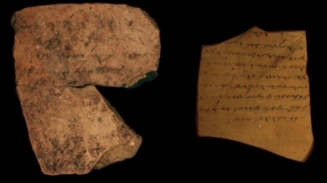
2600年前约旦人已广泛识字
Find Shows Widespread Literacy 2,600 Years Ago in Judah
2600年前约旦人已广泛识字
Mundane notes about daily life on 16 ceramic shards written about 600 B.C. at an ancient military fortress in the Negev Desert reveal that literacy had to be common.
在内盖夫沙漠(Negev Desert)的军事堡垒中发现的公元前600年的16枚陶片上记载的世俗日记昭示了当时人们普遍具有读写能力。
播音/撰文 辛西娅·盖博(Cynthia Graber)
翻译 Meatle
审校 乔虹
统筹 李轩
The Hebrew bible was first written down some 2,600 years ago. And scholars have argued that only a population with sufficiently widespread literacy could have accomplished the task. Now there’s new evidence for such literacy—in the form of notes from that same time period, written in ink on shards of pottery.
《希伯来圣经》(Hebrew bible)的初稿完成于公元前2600年。学界曾认为一个有完善读写能力的文明才能完成这样的一部作品。现在,一项研究为这一学说提供了新证据:一些同时期的文字资料——用墨水写有文字的陶片。
Scientists have debated whether the first significant phase of the compilation of biblical texts happened before or after the fall of the first Temple, in 586 B.C. To get at the potential answers to that question, a group of researchers in Israel analyzed mundane inscriptions about the needs of daily life on 16 ceramic shards written about 600 B.C. from an ancient military fortress in Arad, at the northern edge of the Negev desert. These notes had no direct connection with biblical texts, which were more frequently written on papyrus or parchment and would not have survived the region’s climate. But they reveal that literacy did not belong to a privileged few. The study is in theProceedings of the National Academy of Sciences. [Shira Faigenbaum-Golovin et al, Algorithmic handwriting analysis of Judah’s military correspondence sheds light on composition of biblical texts]
科学家们一直在争论《希伯来圣经》的首次编撰是否在所罗门圣殿的陷落之前,即公元前586年前。为了探明真相,一组以色列的研究人员分析了从阿拉德的古代军事堡垒中挖掘出的约公元前600年的陶片上的世俗文字,这些平常的文字记载着当时的日常所需。这些笔记与圣经没有直接的联系,因为圣经文字通常用莎草纸或羊皮纸书写,而这些材料无法抵御该地区气候。但是,这些笔记却证实了那时候并不只有权贵阶级识字。该项研究发表在《美国国家科学院论文集》(Proceedings of the National Academy of Sciences)上。
The research team was able to determine that the documents—detailing military movements and food expenses—were written by a minimum of six authors. The scientists could even generally identify those authors, who ranged from a military commander down the ranks to a much lower subordinate.
研究人员详细解读了其中的文字,这些由至少6人写就的文字记载着详细的军事行动和食物消耗状况。研究人员甚至能大致确认这些作者的身份,他们包括从军事指挥官到下等随从的多种级别的人。
"This means that not only their priests were able to write, but also the an army administration were literate down to the quartermaster of this fort in the desert.” Shira Faigenbaum-Golovin, a Tel Aviv University researcher involved with the study. “This indicates that in Judah, in the sixth century, there were high literacy ranks in not only the elite people but among simple people also.”
“这意味着不单单神职人员能够写作,连沙漠边上的城堡里的军需官那样的军队管理人员也能识字。”该研究组的成员之一,以色列特拉维夫大学(Tel Aviv University)的茜拉·费根巴姆-戈洛文(Shira Faigenbaum-Golovin)说。“这说明了在公约前6世纪的约旦地区,不但在精英阶级,连小百姓也有很高的识字率。”
Such widespread literacy in the region could have set the stage for the eventual compilation of the Bible, and thus the foundation of the monotheism that still prevails in the West.
这样广泛的识字率为圣经的最终完成铺平了道路,也为神论在西方的普及打下了基础。
未经书面许可任何人不得复制或镜像
京ICP备11000850号-1
 京公网安备11010502039775号
京公网安备11010502039775号 信息网络传播视听节目许可证0111611号
国家科技基础条件平台

















